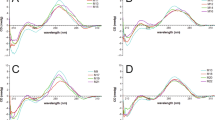Abstract.
Using circular dichroism spectroscopy the ability of berenil, a minor groove binding drug, to induce triple helix formation was investigated with two oligonucleotides designed to form two intramolecular triplexes containing T*A:T and G*G:C triplets, which differ only by the orientation of their third strand: 5′-d(G4A4G4-[T4]-C4T4C4-[T4]-G4T4G4), and 5′-d(G4T4G4-[T4]-G4A4G4-[T4]-C4T4C4), where [T4] represents a stretch of four thymine residues. We demonstrate that when added to the duplex form of these oligonucleotides, berenil induces triplex structure formation only if the orientation of third strand is antiparallel to the purine strand.
Similar content being viewed by others
Author information
Authors and Affiliations
Additional information
Revised version: 21 September 2001
Electronic Publication
Rights and permissions
About this article
Cite this article
Durand, M., Seche, E. & Maurizot, J. Effect of strand orientation on the interaction of berenil with DNA triple helices. Eur Biophys J 30, 625–630 (2002). https://doi.org/10.1007/s00249-001-0192-0
Received:
Accepted:
Issue Date:
DOI: https://doi.org/10.1007/s00249-001-0192-0




